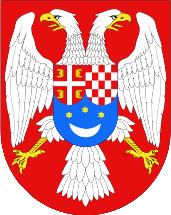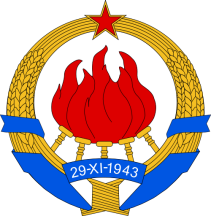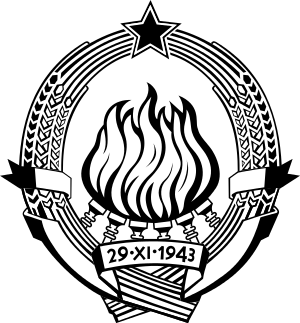U.S.A.
It seems like all the major telegraph companies like Western Union, the Postal and all the other telegraph companies
which were eventually absorbed by Western Union used envelopes exclusively and no seals were used, other than
publicity stickers which were not used for sealing folded telegrams or envelopes. An early telegraph company called
Merchants' Line Telegraph operating out of Providence, Rhode Island, did reportedly use #1 below to seal the envelopes
in which their telegrams were delivered. This company is of interest in that it used the Bain's telegraph system, of one
of Morse's rivals, which worked through a pen on a pendulum and could transmit maps and signatures so that it was effectively
the first fax machine. It is worth googling Alexander Bain and Bain's Telegraph. A second seal which may be regarded as
almost USA is the Marconi seal used in Hawaii in 1916, #2 below.
| Updates. The above was written by Steve Hiscocks, 2007. I have added some and renumbered using 'RH' (Revised Hiscocks) numbers. No pricing as yet. I have seen a wax seal on an 1844 telegram, and paper seals from about 1850. |
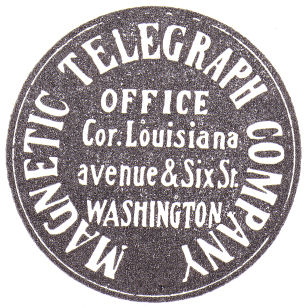 |
 |
| Type 1 1849? 25mm. | Type 4 1850 ? |
Type 1. The 1900 book by Joseph S. Rich entitled 'Some Notes on the Telegraph Companies of the United States; their Stamps and Franks.' illustrates #1 on Page 5.
He says of it '25mm. in diameter, printed on very deep blue glazed paper', this example dated 12 January 1849.
Type 2. The New York & Erie had a similar seal about the same time, inscribed 'OFFICE / No. 5 Hanover / Cor. Beaver St. / NEW YORK'.
On page 8 he then describes a new seal of 1850 inscribed:
Type 3. 'New York & Boston Magnetic Telegraph Association.' on deep blue surface glazed paper
Type 4. I am unsure as the whether this is a branch of THE Eastern, or a local company within the U.S.A.
Type 5. The "Merchant's Line" of the New York & New England Union company
had a rectangular seal (often with corners clipped) with an eagle atop a shield, on glazed paper, in various colors.'
My Note: The Merchants Line seals below had variants for many different offices. The same may be true of the two above.
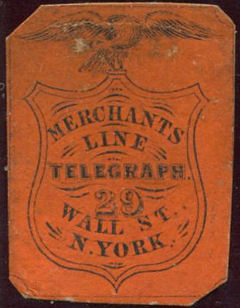 |
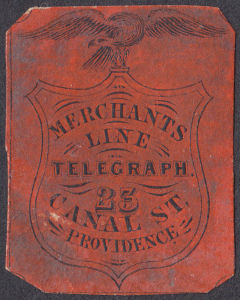 |
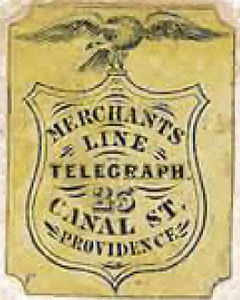 |
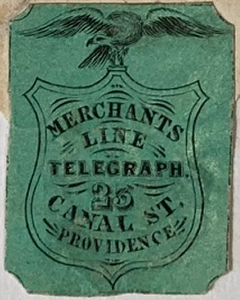 |
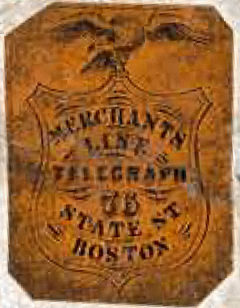 |
| Type 5 16mm (shield), RH5 | Type 5a Canal Street , RH5b | Type 5a Canal Street , RH5c | Type 5a Canal Street , RH5d | Type 5b State Street , RH5e |
According to Joseph S. Rich (1900 Pg.9), these seals had in earlier times been treated as stamps, selling for $20 or more each.
At that time, he knew only of RH5, RH5a, RH5b, RH5c and a RH5f (no illustration).
| RH # | Type. | was | Description | Mint | Used | On cover |
|---|---|---|---|---|---|---|
| RH1 | 1 | - | 1849? Magnetic, Black? on dark blue glazed paper | - | - | - |
| RH2 | 2 | - | 1849? New York & Erie, Silver on dark blue glazed paper | - | - | - |
| RH3 | 3 | - | 1850 NY & Boston , Silver on dark blue glazed paper | - | - | - |
| RH4 | 4 | - | 1850? Eastern, Silver on dark blue glazed paper | - | - | - |
| RH5 | 5 | - | 1850? Imperf. Black on red. Merchants' Line Telegraph. Eagle and shield - Wall St. NY. | - | - | - |
| RH5a | 5 | - | Wall St. NY. Black on yellow | - | - | - |
| RH5b | 5a | 1 | Canal St. Providence, RI. Black on red | - | - | - |
| RH5c | 5a | - | Canal St. Providence, RI. Black on yellow | - | - | - |
| RH5d | 5a | - | Canal St. Providence, RI. Black on green | - | - | - |
| RH5e | 5b | - | State St. Boston. Black on orange | - | - | - |
| RH5f | 5c | - | Chapel Street, New Haven. Black on red | - | - | - |
Merchants Line Offices are known at:
29 Wall Street, New York.
23 Canal Street, Providence, Rhode Island.
76 State Street, Boston, Mass.
6 State Street, Troy, NY
Main Street, Norwich, CT.
146 Chapel Street, New Haven, CT.
Stamford, CT.
Bridgeport, CT.
Middletown, CT.
It is not known which offices used a similar seal, but quite possibly all of them and more. They are not common.
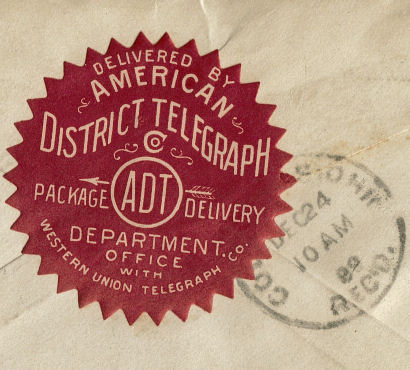 |
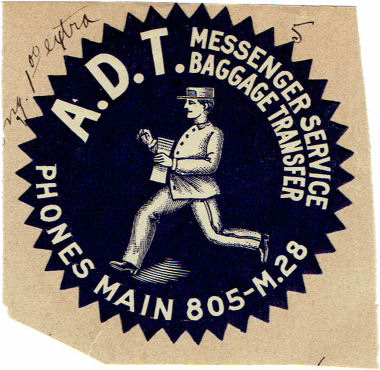 |
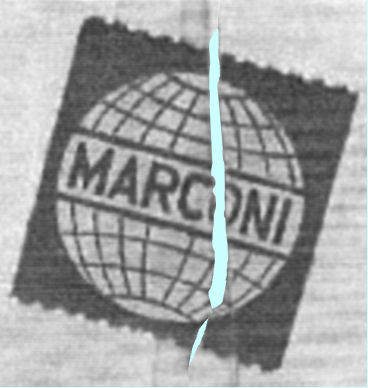 |
| Type 6 ADT 1899 Package delivery | - ADT 1900 Baggage sticker | Type 7 1916 |
I have not included the ADT Baggage sticker as it does not appear to have been used as a seal. It is shown only for reference.
| RH # | Type. | was | Description | Mint | Used | On cover |
|---|---|---|---|---|---|---|
| RH6 | 6 | - | 1899. ADT red on white | - | - | - |
| RH7 | 7 | 2 | 1916. Perf. top and bottom. Red on white. Marconi. | - | - | - |
YUGOSLAVIA
The single seal below was sold as "from Yugoslavia" but I did not obtain it so did not discover whether the date of use
corresponded to the state of Yugoslavia or one of its constituent parts before its formation or after the breakup.
Its colour was lightish blue-grey on white but it has been enhanced for the design to be more visible.
Updates. The above was written by Steve Hiscocks. He showed RH13. |
This double-headed eagle can clearly be confused with those of former Empires.
The clue is in the constituent arms represented.
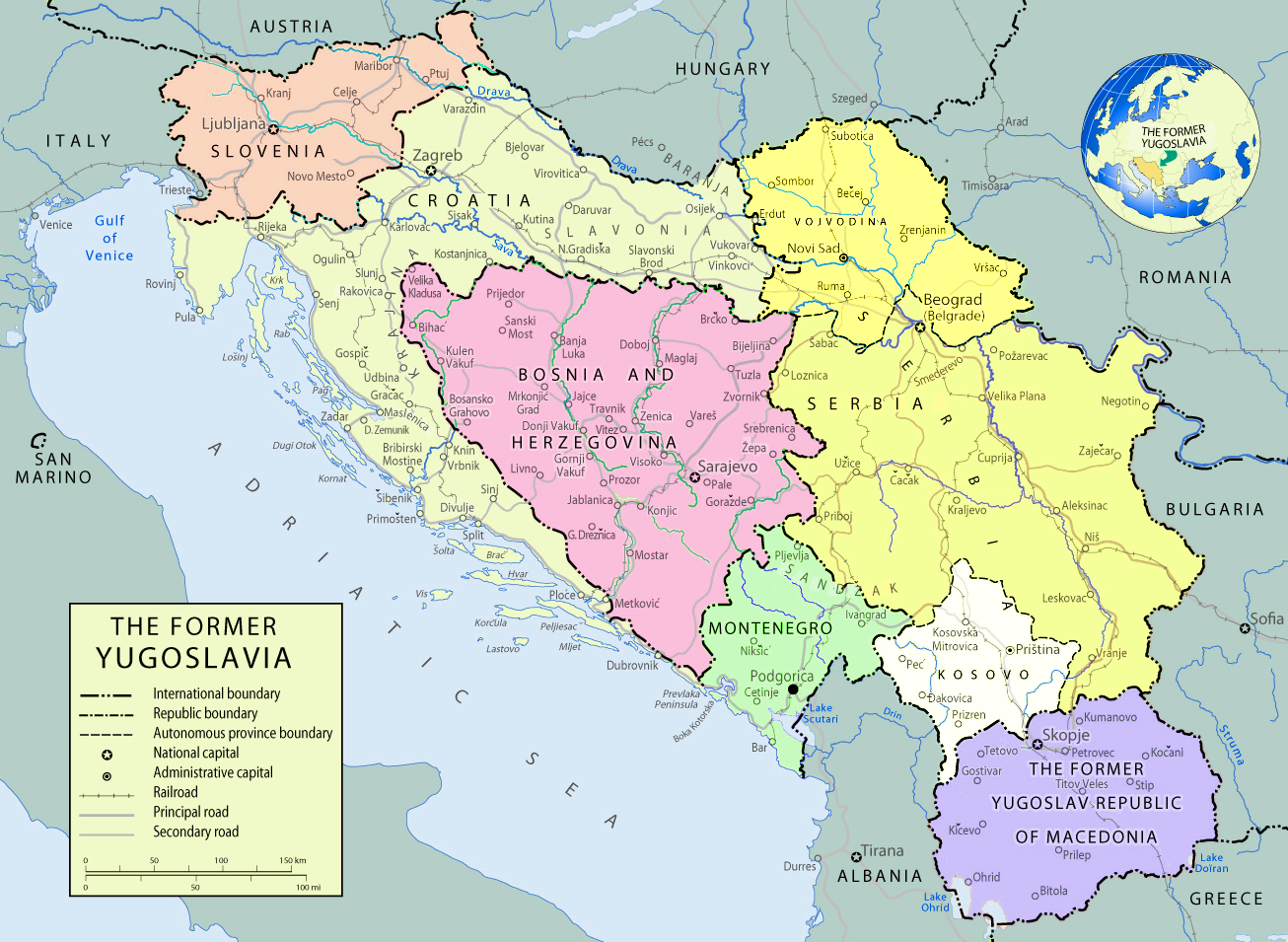
A map may help with this.
Military Telegraph ('ВОЈНИ ТЕЛЕГРАФ' in Serbian).
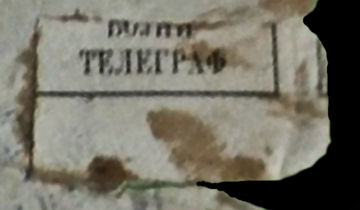 |
| #1 1921? (used in Sarajevo) |
| RH # | Type. | was | Description | Mint | Used | On telegram |
|---|---|---|---|---|---|---|
| RH1 | 1 | - | 1921? Imperf. Black on white. | - | - | - |
YUGOSLAVIA - 1929 to 2003
Serbian Coat of Arms.
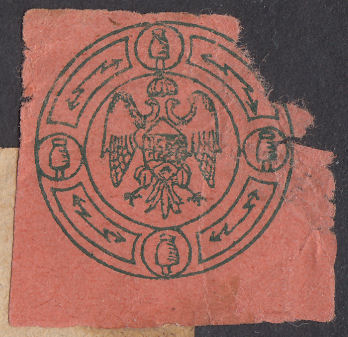 |
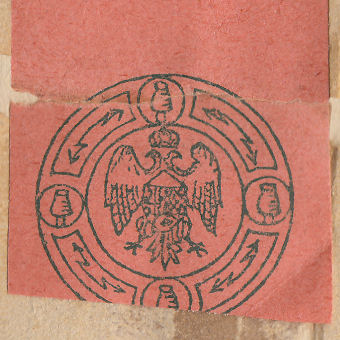 |
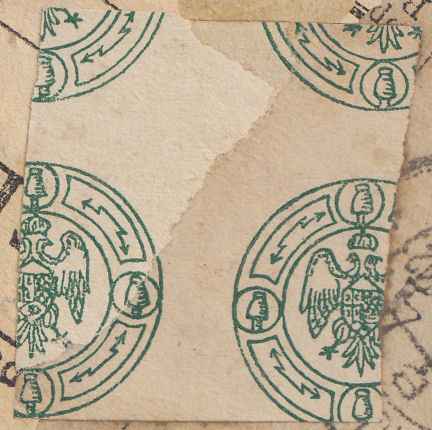 |
| #2a 1925 (April), 22mm | #2b 1925 (April), 22mm Numerous differences of detail, particularly between right leg and tail. |
#3 1925 (October) similar to the previous one, and to the 1939 type. The lightning bolts and wings look different, but these 4 parts also look different to each other. |
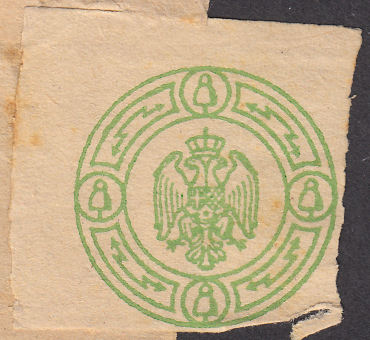 |
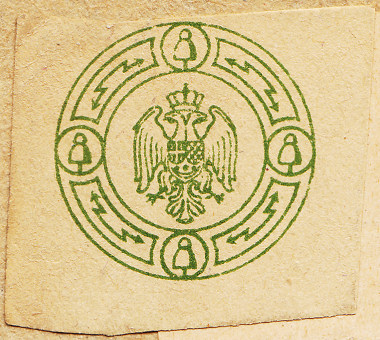 |
| #4 1926, 22.3mm (small eagle) | #4a 1930, 22.2mm (small eagle) |
The shading on the insulators is initially on the right, like similar Austrian seals.
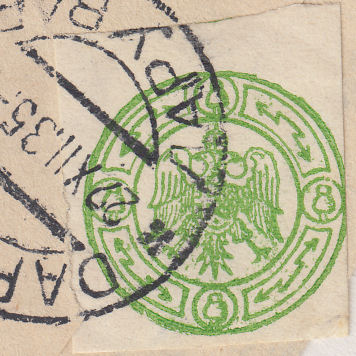 |
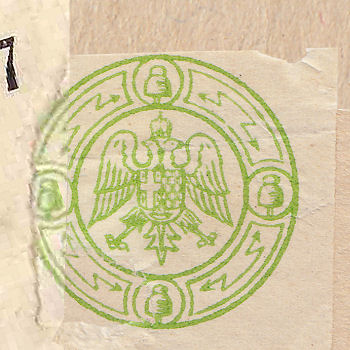 |
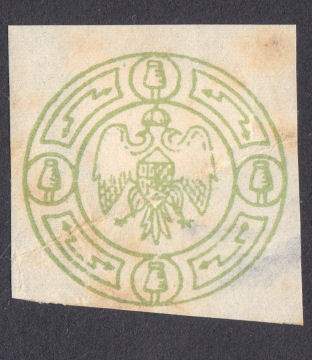 |
| #5 1932-5, 22.5mm (different crown) | #6 1933-6, 22mm (different tail) Osijek |
#7 1939-41, 22mm (wings narrower) |
#10 appears to be a return to the 1925 design.
| RH # | Type. | was | Description | Mint | Used | On telegram |
|---|---|---|---|---|---|---|
| RH2 | 2 | - | 1925 Imperf. Black on red. Eagle and insulators. | - | - | - |
| RH3 | 3 | - | 1925 Imperf. Dark green on white. Eagle and insulators. | - | - | - |
| RH4 | 4 | - | 1926-29 Imperf. Dull Blue-green on white. Eagle and insulators. | - | - | - |
| RH4a | 4 | - | 1930-35 Imperf. Olive-green on white. Eagle and insulators. | - | - | - |
| RH5 | 5 | - | 1932-5 Imperf. Green on white. Eagle and insulators. | - | - | - |
| RH6 | 6 | - | 1933-6 Imperf. Green on white. Eagle and insulators. Different tail. | - | - | - |
| RH7 | 7 | Croat#2 | 1939-41 Imperf. Yellow-green on white. Eagle and insulators. | - | - | - |
Up to 1941, the shading on insulators is on the right, but during the NDH period in late 1942 or early 1943, switched to the left.
This might be helpful in dating unknown seals. Croatia did the same about this time. I do not know the significance of this.
HRVATSKA
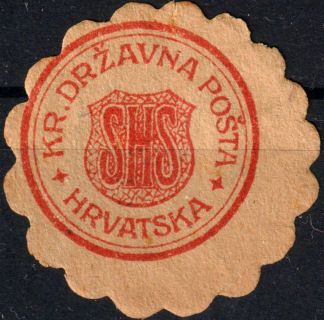 |
| #8 1919?, 22.1mm ? |
DRŽAVNA POŠTA is State Post in Croatian (and Slovenian), but I don't know what the "KR." means, though it was on the seals of Croatia-Slavonia.
I had thought there that it related to it being a Kingdom, but those had a Crown, whereas this does not.
This is clearly marked "SHS" (Serbs, Hrvatska and Slovenes) together with "Hrvatska", meaning Croatia. No Cyrillic, no insulators and no Crowns.
The scalloping is remeniscent of Croatia-Slavonia and I have scaled it on that basis, though I do not know the size.
It seems likely that there is a sinilar one for Slavonia and perhaps even Serbia for use in appropriate areas.
It may even be that some have "CXC" within the shield. As yet, this is the only example I have seen (thanks Krisztián). Similar examples would be welcome.
It is placed here since Yugoslavia existed in 1919, Croatia-Slavonia had ceased to exist and Croatia had no autonomy until 1939 (as a province within Yugoslavia).
| RH # | Type. | was | Description | Mint | Used | On telegram |
|---|---|---|---|---|---|---|
| RH8 | 8 | - | 1919? scalloped(17). Red on white. SHS in shield. | - | - | - |
S.C.S / С.Х.С (Serbs, Croats and Slovenes) Postal Administration - 1918 to October 1929
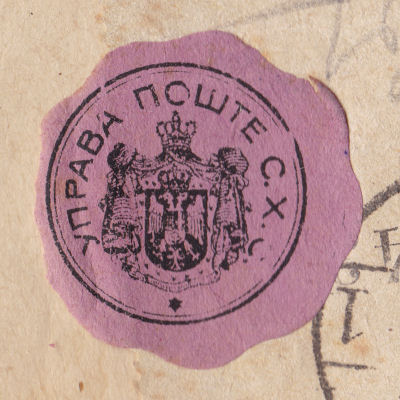 |
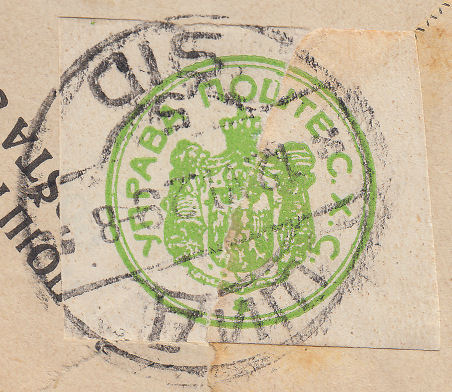 |
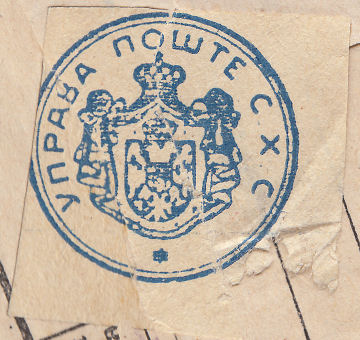 |
| #9 1923, 22.1mm, (Vršac) | #10 1929-31, 23mm, (Shid) | #11 1933-40, 23mm, (Novi Sad and Sombor) |
#9, #10 and #11 were used on telegrams but have 'Postal Administration' at the top.
#9 was used in Vršac (Вршац), in the South Banat District of Vojvodina, one of the two
Socialist Autonomous Provinces within Jugoslavia, the other being Kosovo.
These were within the Socialist Republic of Serbia within Jugoslavia.
#10 was used in Šid (Шид), in the Syrmia District of Vojvodina.
#11 is very similar in blue, though the crown is different. My examples are used in
Novi Sad (Нови Сад), the capital of Vojvodina and Sombor (Сомбор) also in Vojvodina.
The 1940 one was used in Erdevik (Ердевик), Šid municipality, in the Srem District, Vojvodina province.
| RH # | Type. | was | Description | Mint | Used | On telegram |
|---|---|---|---|---|---|---|
| RH9 | 9 | - | 1923 Scalloped 8. Black on Mauve. Kingdom Emblem. | - | - | - |
| RH10 | 10 | - | 1929-31 Imperf. Green on white. Kingdom Emblem. | - | - | - |
| RH11 | 11 | - | 1929 Imperf. Dark blue on white. Kingdom Emblem. | - | - | - |
| RH11a | 11 | - | 1933-40 Imperf. Light blue on white. Kingdom Emblem. | - | - | - |
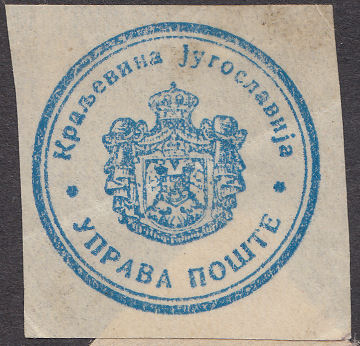 |
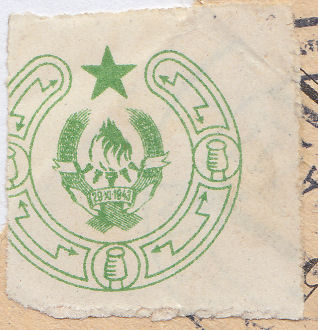 |
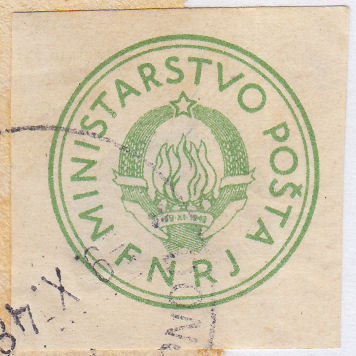 |
| #12 1935-43 | #13 1946-7, 20.5mm | #14 1947-8, 23.2mm |
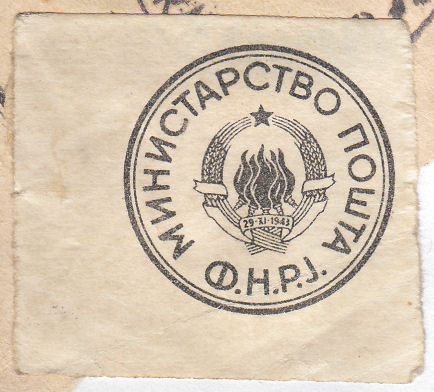 |
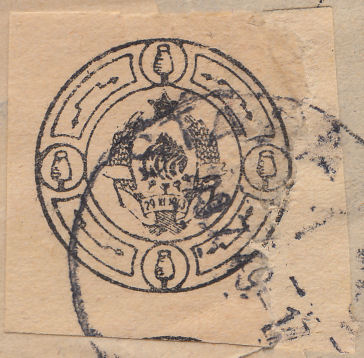 |
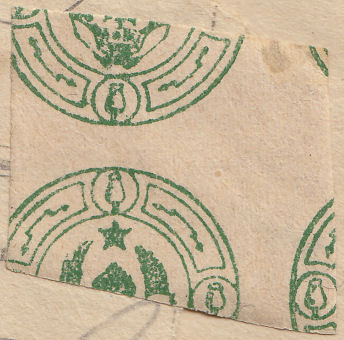 |
| #15 1949 23.2mm. Cyrillic FNRJ | #16 1948-52, 22mm | H16a 1949-50 |
#12 says 'Краљевина Југославија / Управа Поште' (in Serbian Cyrillic) or 'Kingdom of Yugoslavia / Management of Post',
but I have seen them used on two telegrams. The name 'Kingdom of Yugoslavia' was given October 1929
#14 has Latin script for the Ministry of posts with FNRJ at the bottom.
This means 'Federativna Narodna Republika Jugoslavija' (Federal People's Republic of Jugoslavia)
The name used from 1945. Again, seen used on a telegram, this marked 'MINISTARSTVO POSTA'.
#15 has the same in Cyrillic script.
#16, like #2-7 and #13 seems to be for telegrams only. The others, though ostensibly for postal use, were often used on telegrams too.
#16 was used at Stara Fuzina, Federal Republic of Slovenia. I have another used on the island of Sutivan, Brač in July 1950.
| RH # | Type. | was | Description | Mint | Used | On telegram |
|---|---|---|---|---|---|---|
| RH12 | 12 | Serb#3 | 1935-43 Imperf. Dark blue on white. Kingdom Emblem. | - | - | - |
| RH13 | 13 | - | 1946-7 Imperf. Green on white. 1943 emblem. | - | - | - |
| RH14 | 14 | #1 | 1947? Imperf. Light blue-grey on white. 1943 emblem. FNRJ. | - | - | - |
| RH14a | 1947-8, grey-green on white. | - | - | - | ||
| RH15 | 15 | - | 1949 Imperf. black on white. 1943 emblem. Cyrillic FNRJ. | - | - | - |
| RH16 | 16 | Croat#4 | 1948-52 Imperf. Black on buff. 1943 emblem and insulators. | - | - | - |
| RH16a | - | 1949-50, dark green on buff. | - | - | - |
According to Wikipedia: "During World War II, Zagreb became the capital of the Independent State of Croatia,
which was backed by Nazi Germany and Italians. The city was liberated by the partisans at the end of the war."
The (half size) fragment of telegram below dated 1946 and used in Zagreb with a Yugoslavian seal, shows the Croatian arms at the top overprinted with the arms of Yugoslavia.
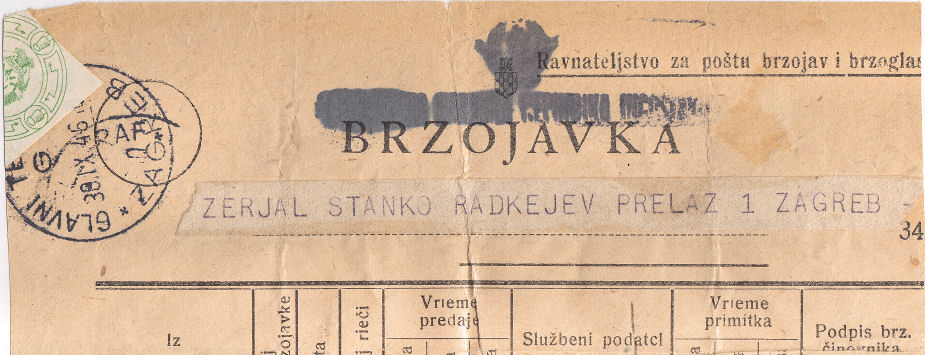
This similar one from a few days later, used in Donji Miholjac has the Croatian arms overprinted with a star.
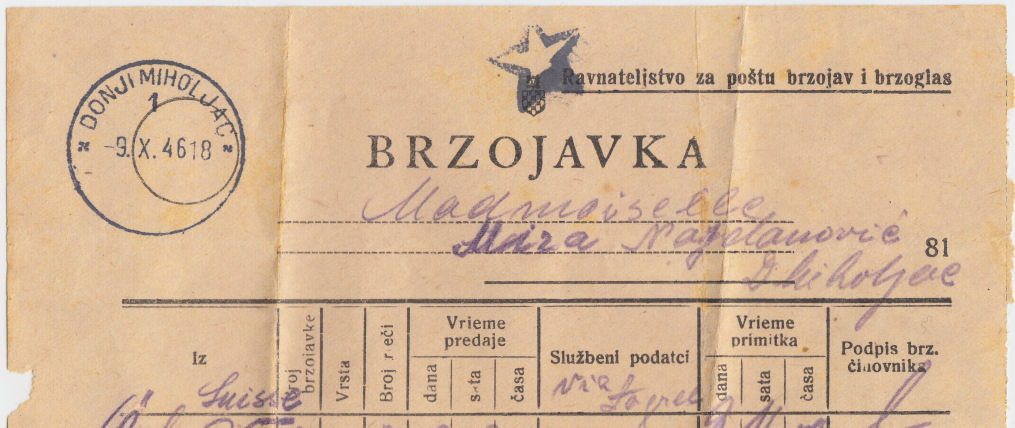
These should be considered as Croatian converted for use in Yugoslavia.
I have not seen any without such overprinting and suspect that they are rare.
This one is interesting, it has no indication of country and was sold as being Russian, used in Saint Petersburg. However it is Петровград / Petrovgrad not Петроград / Petrograd.
Additionally it is dated 1943, at which time Petrograd was called Leningrad. It appears to be written in Bosnian. At this time, the city called Petrovgrad from 1935 to 1946
was in Vojvodina, Yugoslavia and occupied by German forces. In 1946 the city was re-named Zrenjanin and is now in Serbia.
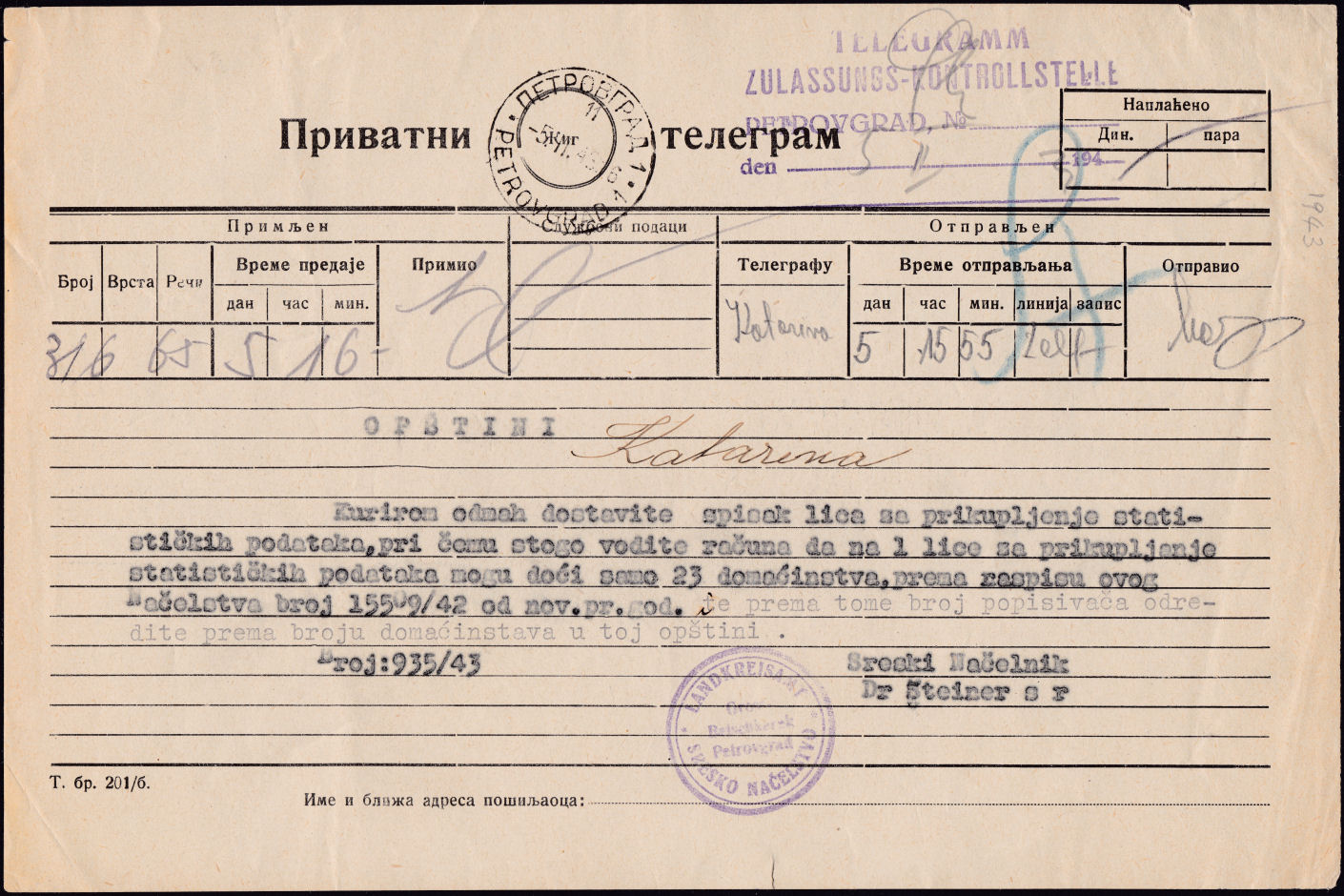
By the end of 1952 (in Zagreb at least), telegrams were sent in envelopes so that seals were no longer needed.
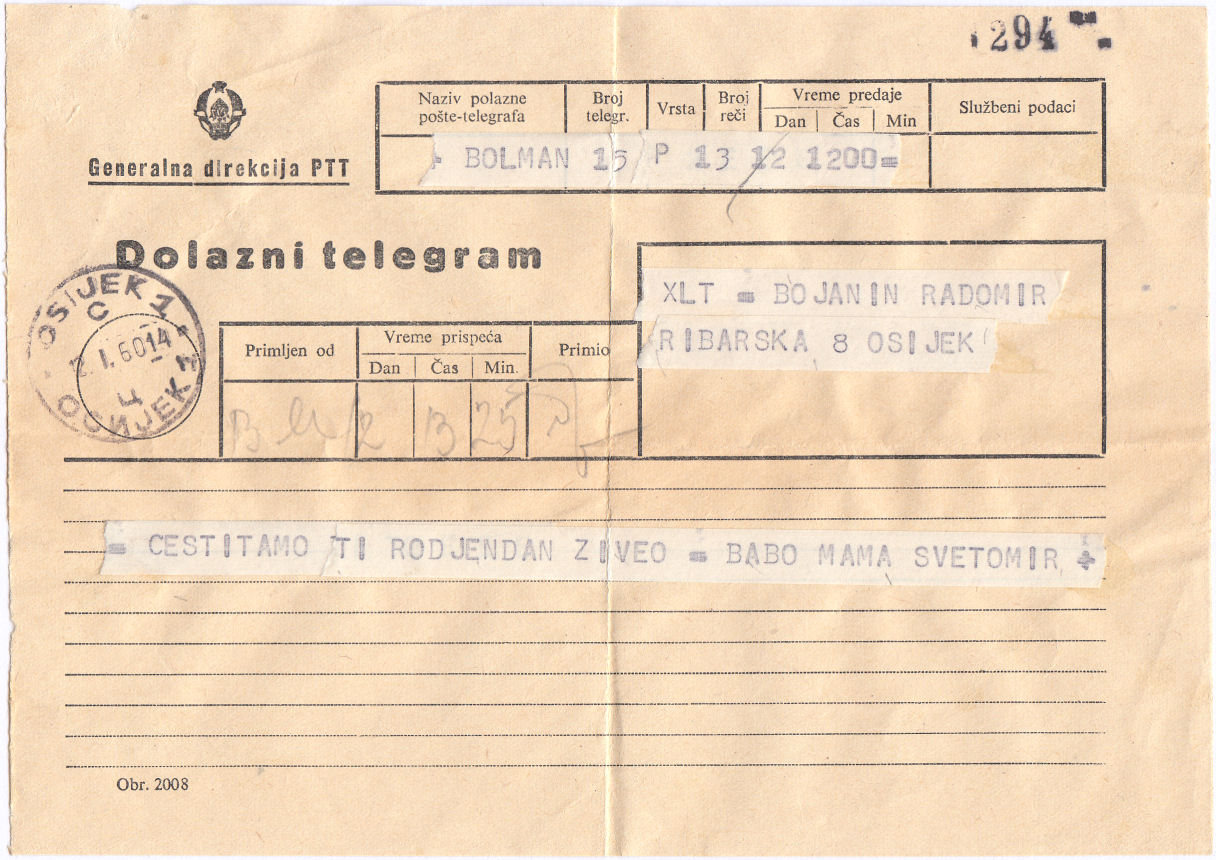
Here is a telegram dated 12/1/60 used in Osijek.
If anyone can provide scans to help with this, I am happy to give appropriate credit.


